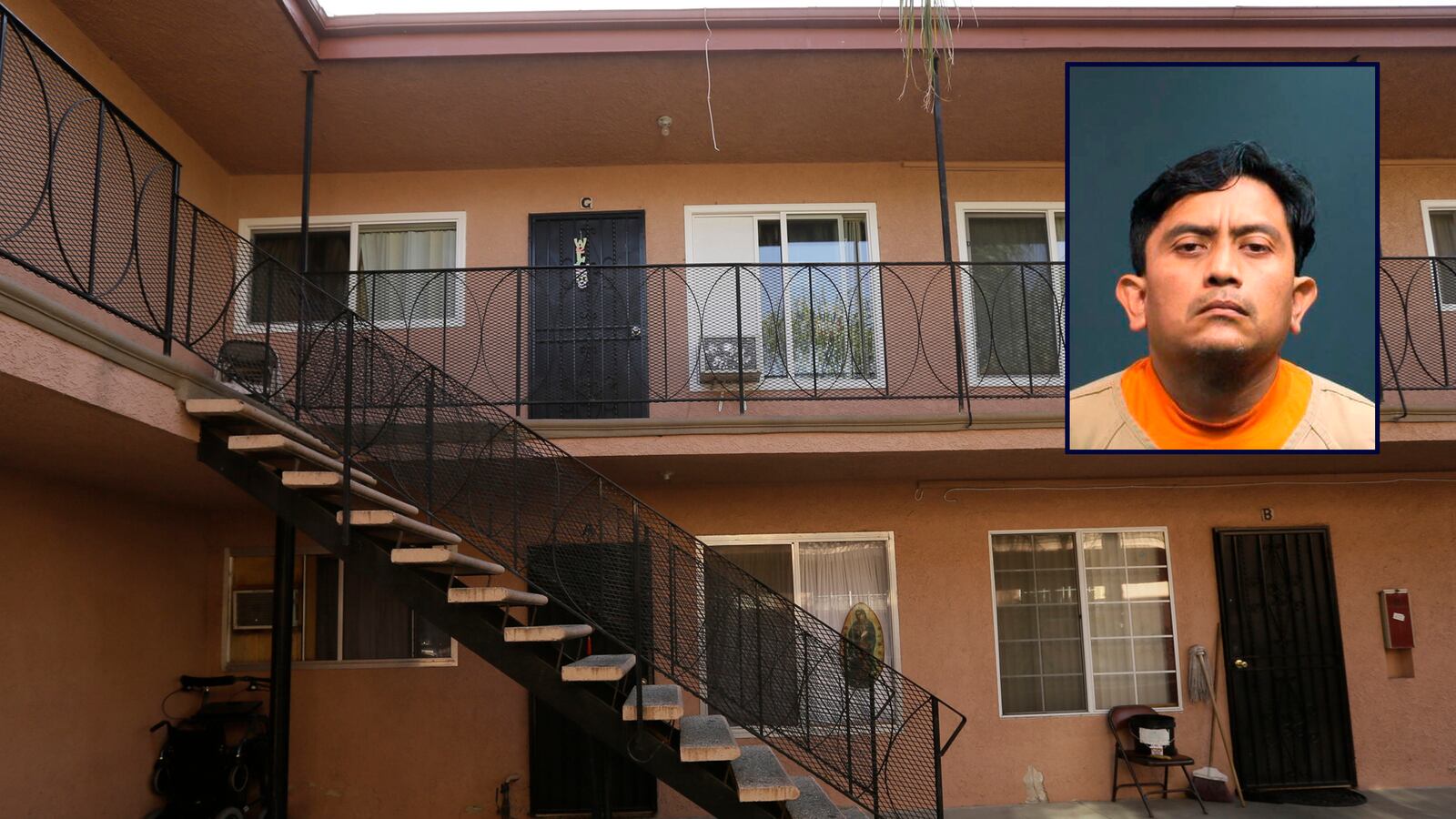The 25-year-old woman who came forward this week, saying she had held been captive for 10 years, was trapped by a special threat all too familiar to the 11 million undocumented immigrants in the United States: the threat of deportation.

According to police, the young woman, who has not been identified, immigrated to California from Mexico illegally, not knowing a word of English, in March 2004 to reunite with her mother, who had been living with Isidro Garcia in Santa Ana. The woman’s mother filed a police report when she first went missing and told officers that she suspected Garcia had sexually abused her daughter. But Garcia and the woman were on the move, evading authorities by regularly relocating, changing their names and birth dates. While physically abusing her, Garcia also convinced the woman that if she went to the police, she and her family would be deported, police say. The more he repeated the threat, and the more time went by without hearing from her mother, the more convinced the woman became that she was trapped—and terrified of seeking help.
“I was 15. I couldn’t do anything,” she said in a teary interview with ABC News Los Angeles. “I was afraid about everything because I was alone.”
Santa Ana police received a visit Monday from the woman, who said she’d been drugged and kidnapped by Garcia, forced to marry him, carry his child, and held captive for 10 years. He was arrested the same day on felony charges of forcible rape, lewd acts on a minor, and kidnapping to commit a sexual offense.
The woman’s story highlights a problem that has long plagued the vast but silent world of undocumented immigrants in the United States, where fear of deportation discourages people from seeking police assistance, even in the direst emergencies. It’s an issue that, by its nature, is virtually impossible to quantify.
“There is a fear of police and availing yourself of police protection,” said Clara Long, a researcher at Human Rights Watch. “The fact that someone could be held for 10 years and convinced that she could endanger her family is very telling of the situation.”
Starting in the mid-’90s, U.S. Immigration and Customs Enforcement trained to state and local police to help enforce immigration law under a federal program called 287(g). With ICE’s authorization, law enforcement officers were able to identify, process, and even detain undocumented immigrants they encountered during their regular policing activities. Detentions and deportation proceedings for minor offenses such as driving without a license sparked national debate over what kinds of undocumented criminals should be targeted and undoubtably had a chilling effect on victims.
In December 2012, ICE announced that it would “not renew any of its agreements with state and local law enforcement agencies that operate task forces under the 287 (g) program” but rather focus on other programs that it said were “a more efficient use of resources for focusing on priority cases.” One of those programs is Secure Communities, which shifts the authority to enforce immigration law back to federal officials. But since it was implemented, Secure Communities drawn criticism of its own.
The program requires state and local law enforcement to share fingerprints and other personal data from foreign-born arrestees with ICE, which may then ask sheriff’s offices to keep suspected undocumented immigrants in jail while ICE processes them for deportation. Although the entire system initially was presumed to be mandatory, a number of states and counties have recently said they will no longer detain people at ICE’s behest without a court order or probable cause. Sheriff’s offices all over Oregon, for example, announced they were suspending the use of Secure Communities’ detention policy after a federal court judge in the state ruled that holding a woman for immigration authorities without any probable cause had violated her Fourth Amendment rights. Just Thursday, California’s Alameda County Sheriff’s Office followed suit.
The backlash against Secure Communities has certainly attracted the federal government’s attention. During an interview with PBS NewsHour last week, Homeland Security Secretary Jeh Johnson said he’s taking a “fresh look” a Secure Communities, suggesting his highly anticipated review of immigration enforcement policies may include a makeover of the program.
“I think Secure Communities was a real step back in people’s sense of security,” said Long. “These programs create an intermingling of public safety and immigration enforcement. As long as that intermingling continues, we will have a situation where people are afraid to call the police and can’t get meaningful police protection.”
This week, Human Rights Watch released a report spotlighting Nashville and the connection between such law enforcement programs and the deep-seated fear of police among the city’s undocumented immigrants. The report points to a 2008 study by the National Council of La Raza and the Tennessee Immigrant and Refugee Rights Coalition that analyzed how Hispanics respond to crime compared to African-Americans. According to the study, 4 percent of African-American respondents said they knew of a crime that had not been reported to the police, while 42 percent of Hispanics said the same thing. Twenty-seven percent of African-Americans said they would not report a crime to the police, compared to 54 percent of Hispanics.
A 2012 study by the University of Illinois at Chicago of Hispanics living in Chicago, Los Angeles, Houston, and Phoenix revealed similar results. Forty-four percent of Hispanic respondents said “they are less likely to contact police officers if they have been the victim of a crime because they fear that police officers will use this interaction as an opportunity to inquire into their immigration status or that of people they know.” Seventy percent of undocumented immigrants said they were less likely to contact law enforcement if they were the victims of a crime. But the fear isn’t just limited to undocumented immigrants or even those with legal status: Twenty-eight percent of U.S.-born Hispanics said “they are less likely to contact police officers if they have been the victim of a crime because they fear that police officers will use this interaction as an opportunity to inquire into their immigration status or that of people they know.” The UIC researchers suggest that these responses are a result of programs involving state and local police in immigration enforcement. Overall, they found a sense of isolation from law enforcement by Hispanics, a desire to withdraw from the community and even a fear among many to leave their homes. Increased police involvement in immigration enforcement also seems to have resulted in many Hispanics feeling less safe. According to the report, “many Latinos say criminals are moving into their neighborhoods, making them and their neighbors less safe, because criminals know residents are less likely to report them to police given the increased involvement of police in immigration enforcement.”
Of course, Hispanics aren’t necessarily less likely to report crimes because they are illegal, but Long pointed out that many Americans live in “mixed-status” families. “You may have legal status but are afraid to call the police and jeopardize your other family members,” she said.
Certain federal—and increasingly more local—programs have been developed in an effort to combat that mentality. The most recent iteration of the Violence Against Women Act, signed by President Obama in 2013, extends protections from domestic abuse to women living in the country illegally. The act makes resources such as shelters and protective orders available to women who previously might have been afraid to expose themselves by seeking help and encourages undocumented immigrants to report abuse to the police in exchange for protection from prosecution and deportation.
Other programs, such as U-visas, offer immigration protections for certain victims of crimes who are willing to provide credible information that may help in a police investigation. T-visas work in the same way but only for victims of human trafficking. Both of these programs, however, are limited by a quota and subject to the discretion of U.S. Citizenship and Immigration Services, hardly making them something immigrants can count one when they become the victim of a crime.
One woman profiled in the Human Rights Watch report did not want to report her daughter’s assault out of fear that she could be deported. This woman’s fear, and that of the woman who says she was kidnapped in Santa Ana, are not based in real immigration consequences, as victims of crimes are not fingerprinted and processed the way accused criminals are. Rather, as HRW argues, they may be a product of such enforcement programs that create the impression that a visit to the police station means an automatic phone call to ICE. Many who have risked their lives to be in the United States would rather let a crime go unreported than risk deportation. Such a mentality also can make the undocumented vulnerable to attacks by people who assume they won’t tell.
Garcia’s arrest came as a complete shock to neighbors in Bell Gardens, the working-class Los Angeles community where he and his “wife” were often seen with their young daughter, hosting parties and living a seemingly normal life.
“He treats her like a queen,” one neighbor told CBS News of the 41-year-old man who allegedly attacked his former girlfriend in August 2004 and then tracked down her then-15-year-old daughter, gave her five unidentified pills, and drove her to a garage in Compton, where she woke up trapped. “He does his best to do whatever she wants.”
“I just don’t understand how he could have her like that all these years,” said another neighbor to the Los Angeles Times. “The police station is right around the corner.”
Garcia’s defense attorney is already attempting to use such statements to bolster his argument that his client was nothing less than a doting husband. But authorities insist that just because the woman wasn’t chained up or locked out of sight doesn’t mean she wasn’t every bit a prisoner, regularly subjected to physical and emotional abuse. To the unknowing eye, she may have seemed like a normal wife and mother, with her own car, even a job, free to come and go and interact with people as she pleased. She even used the Internet—allegedly reuniting with her sister on Facebook before approaching the cops.
Now Garcia is being held on $1 million bond and faces life in state prison if convicted of all three crimes. Even if he managed to come up with the bail money, Garcia would be detained by U.S. Immigration and Customs Enforcement, suggesting that he, not his alleged victim or her family, was the person really in danger of being deported all these years.






